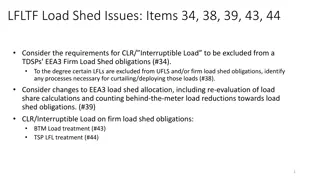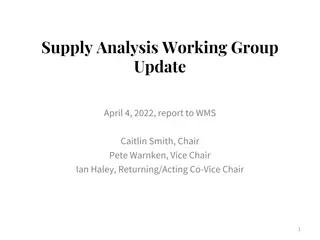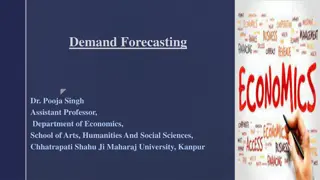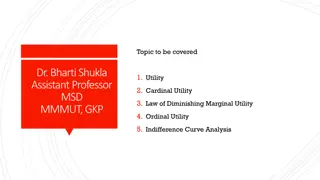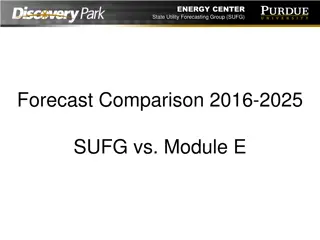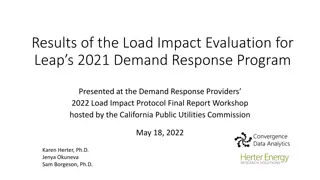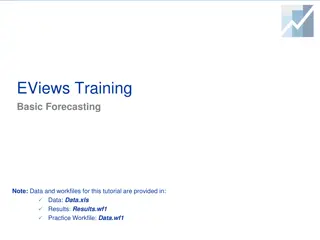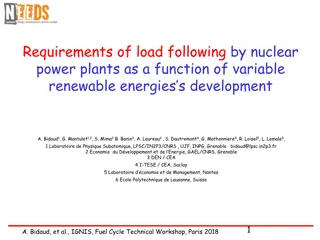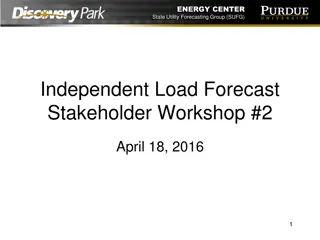Energy Center State Utility Forecasting Group (SUFG) Independent Load Forecasting Report
The Energy Center State Utility Forecasting Group (SUFG) presented draft results and approach changes for 2016 in their Independent Load Forecast for the MISO Planning Advisory Committee. Their methodology includes adjustments for energy efficiency, demand response, and distributed generation, as well as energy to peak conversion strategies. The SUFG's analysis also covers weather normalization and forecast comparisons at different levels.
Download Presentation

Please find below an Image/Link to download the presentation.
The content on the website is provided AS IS for your information and personal use only. It may not be sold, licensed, or shared on other websites without obtaining consent from the author. Download presentation by click this link. If you encounter any issues during the download, it is possible that the publisher has removed the file from their server.
E N D
Presentation Transcript
ENERGY CENTER State Utility Forecasting Group (SUFG) Independent Load Forecast MISO Planning Advisory Committee October 19, 2016
ENERGY CENTER State Utility Forecasting Group (SUFG) Draft Results While these results have been shared with stakeholders, they are subject to revision based on stakeholder comments Stakeholder comments were due October 17 2
ENERGY CENTER State Utility Forecasting Group (SUFG) Approach for 2016 Changes in approach from Year 1 to Year 2 were continued in Year 3 Energy efficiency, demand response, and distributed generation (EE/DR/DG) Model multiple weather stations in the state econometric models Confidence intervals that capture uncertainty around the macroeconomic variables Conversion of the energy forecasts to peak forecasts further adjusted from 2015 3
ENERGY CENTER State Utility Forecasting Group (SUFG) EE/DR/DG Adjustments In the 1st year, adjustments were made at the state level based on state mandates, supplemented with discussions with individual state experts Last year and this year, net forecasts are determined using adjustments at the LRZ level the economic potential from the AEG study was input to EGEAS; the amount selected by EGEAS is used here 4
ENERGY CENTER State Utility Forecasting Group (SUFG) Energy to Peak Conversion In 2015 we used an after-the fact adjustment to correct for bias in the model results The models provided mean load for a given temperature, but peaks occur at the tails of the distribution It was suggested that we use binary variables instead We have implemented this; some binary variables have weak statistical significance but the results of this model formulation were not directionally biased 5
ENERGY CENTER State Utility Forecasting Group (SUFG) Other Analyses Weather normalization We used the models developed for the ILF to estimate the effect of weather on historical energy and peak demands at the LRZ and MISO levels Forecast comparison We provided comparison charts of the ILF and Module E forecasts Results of these analyses are on the MISO ILF webpage 6
ENERGY CENTER State Utility Forecasting Group (SUFG) Embedded DSM Per stakeholder request, we are attempting to estimate the impact of DSM on the historical data used to construct our models and the potential for double counting with the EE/DR/DG adjustments in the forecast 7
ENERGY CENTER State Utility Forecasting Group (SUFG) LRZ-level Results: 2017-26 CAGR LRZ 1 2 3 4 5 6 7 8 9 10 Gross Energy Net Energy Net Peak 1.68 1.49 1.66 0.64 1.25 1.32 1.07 1.07 0.94 1.63 1.59 1.49 1.32 0.45 1.10 1.25 0.87 1.06 0.90 1.63 1.41 1.36 1.17 0.44 1.12 1.20 0.81 0.97 0.84 1.63 Notes CAGR compound annual growth rate (%) Gross prior to adjustments for energy efficiency, demand response, and distributed generation Net after adjustments for energy efficiency, demand response, and distributed generation 8
ENERGY CENTER State Utility Forecasting Group (SUFG) LRZ-level Results Graphical comparison of LRZ-level forecasts are included in the Appendix to this slide deck 9
ENERGY CENTER State Utility Forecasting Group (SUFG) MISO-level Results: CAGR Year 1 (2015-2024) Year 2 (2016-2025) Year 3 (2017-2026) Gross Energy 1.42 1.33 1.25 Net Energy 0.87 1.13 1.15 Gross Summer Peak 1.42 1.30 1.24 Net Summer Peak 0.86 0.96 1.06 Gross Winter Peak 1.41 1.32 1.25 Net Winter Peak 0.86 0.91 1.02 Notes CAGR compound annual growth rate (%) Gross prior to adjustments for energy efficiency, demand response, and distributed generation Net after adjustments for energy efficiency, demand response, and distributed generation 10
ENERGY CENTER State Utility Forecasting Group (SUFG) 11
ENERGY CENTER State Utility Forecasting Group (SUFG) DR Assumption All available DR was included in the adjustment, which reduces demand throughout the forecast period This will not always be the case in reality because sometimes it will not be needed Thus, the net peak forecast will be lower than actual if all DR is not called upon This is a common assumption when forecasting for resource needs 12
ENERGY CENTER State Utility Forecasting Group (SUFG) 13
ENERGY CENTER State Utility Forecasting Group (SUFG) 14
ENERGY CENTER State Utility Forecasting Group (SUFG) Summary Gross forecast is slightly lower (5-10 GWh, 400-1100 MW) than the Year 2 forecast The EE/DR/DG adjustment is somewhat smaller this year Resulting net forecast is nearly identical to the Year 2 forecast 15
ENERGY CENTER State Utility Forecasting Group (SUFG) 90/10 Net Forecasts: CAGR 2017-2026 BASE HIGH LOW Energy 1.15 1.58 0.65 Summer Peak 1.06 1.51 0.52 Winter Peak 1.02 1.48 0.49 16
ENERGY CENTER State Utility Forecasting Group (SUFG) Next Steps Report due November 1 Continued work on embedded DSM 17
ENERGY CENTER State Utility Forecasting Group (SUFG) Contact Information State Utility Forecasting Group 765-494-4223 http://www.purdue.edu/discoverypark/energy/SUFG/ Doug Gotham 765-494-0851 gotham@purdue.edu 18
ENERGY CENTER State Utility Forecasting Group (SUFG) Appendix 19
ENERGY CENTER State Utility Forecasting Group (SUFG) Notes The estimated hourly historical loads for LRZs 8 and 9 that were used in the 2014 forecast were erroneous. This was corrected for the 2015 and 2016 forecasts. LRZ 10 is included in LRZ 9 in the 2014 forecast and is separate in the 2015 and 2016 forecasts. 20
ENERGY CENTER State Utility Forecasting Group (SUFG) Notes LRZ peak demands are coincident at the LRZ level and non-coincident at the MISO-system level. Gross and net forecasts are presented separately for peak demand for the sake of clarity. 21
ENERGY CENTER State Utility Forecasting Group (SUFG) Annual Energy 22
ENERGY CENTER State Utility Forecasting Group (SUFG) 23
ENERGY CENTER State Utility Forecasting Group (SUFG) 24
ENERGY CENTER State Utility Forecasting Group (SUFG) 25
ENERGY CENTER State Utility Forecasting Group (SUFG) 26
ENERGY CENTER State Utility Forecasting Group (SUFG) 27
ENERGY CENTER State Utility Forecasting Group (SUFG) 28
ENERGY CENTER State Utility Forecasting Group (SUFG) 29
ENERGY CENTER State Utility Forecasting Group (SUFG) 30
ENERGY CENTER State Utility Forecasting Group (SUFG) 31
ENERGY CENTER State Utility Forecasting Group (SUFG) 32
ENERGY CENTER State Utility Forecasting Group (SUFG) Peak Demand 33
ENERGY CENTER State Utility Forecasting Group (SUFG) 34
ENERGY CENTER State Utility Forecasting Group (SUFG) 35
ENERGY CENTER State Utility Forecasting Group (SUFG) 36
ENERGY CENTER State Utility Forecasting Group (SUFG) 37
ENERGY CENTER State Utility Forecasting Group (SUFG) 38
ENERGY CENTER State Utility Forecasting Group (SUFG) 39
ENERGY CENTER State Utility Forecasting Group (SUFG) 40
ENERGY CENTER State Utility Forecasting Group (SUFG) 41
ENERGY CENTER State Utility Forecasting Group (SUFG) 42
ENERGY CENTER State Utility Forecasting Group (SUFG) 43
ENERGY CENTER State Utility Forecasting Group (SUFG) 44
ENERGY CENTER State Utility Forecasting Group (SUFG) 45
ENERGY CENTER State Utility Forecasting Group (SUFG) 46
ENERGY CENTER State Utility Forecasting Group (SUFG) 47
ENERGY CENTER State Utility Forecasting Group (SUFG) 48
ENERGY CENTER State Utility Forecasting Group (SUFG) 49
ENERGY CENTER State Utility Forecasting Group (SUFG) 50







